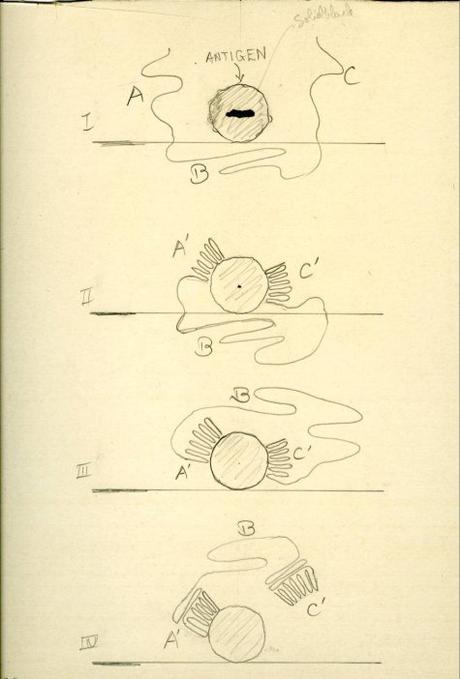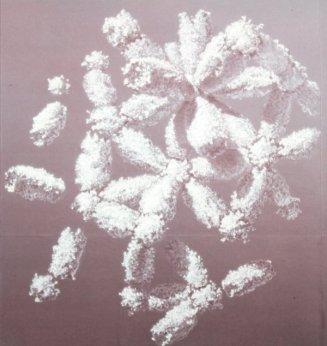
Linus and Ava Helen Pauling, Oxford, 1948.
[The serological properties of simple substances – part 4 of 6]
By the Spring of 1946, having published no fewer than twelve articles – over a little more than three years – on the serological properties of simple substances, Linus Pauling’s busy life began to get in the way of continued advancement of his research program. Perhaps chief among competing interests was a separate fifteen-year joint research program, funded by a $300,000 grant, that Pauling and George W. Beadle, the head of Biology at Caltech, were in the midst of setting up.
Pauling had also returned to studies of sickle cell anemia with the arrival of Dr. Harvey Itano in the fall of 1946. He was likewise engaged with new inquiries in inorganic chemistry that reached a crescendo with a famous article, “Atomic Radii and Interatomic Distances in Metals,” published in March 1947. From there, the dawn of 1948 saw Pauling moving to England, where he served as George Eastman Professor at Oxford University. Not long after, he received the Presidential Award for Merit for work done during World War II. Clearly there was much going on in Pauling’s world.

Drawings of antibodies and antigens made by Linus Pauling in the 1940s.
Nonetheless, consequential progress continued to be made in the serological program with the thirteenth paper – an important one – coming into print in April 1948, while Pauling was still in England. This article, written by Pauling along with David Pressman and John Bryden, marked a continuation of the precipitation experiments that had been carried out in the previous two papers, but this time with a different antiserum and antigen substitute. The Paper XIII experiments determined that antibodies are rigid and cannot change shape to bond to a different antigen.
Significantly, these data also confirmed that structural complementarity was responsible for the reaction’s specificity, affirming Pauling’s early notions of a “hand in glove” fit. Furthermore, the paper’s findings established that the principal forces involved in the complementary bonds were Van der Waals interactions – very weak bonds induced by sheer proximity. In short, the experiments verified the importance of intermolecular interaction in the specificity of serological reactions, a significant breakthrough.
With Pauling now having returned stateside, the year 1949 saw the publication of the final two serological articles, one released in January and another during the summer. Paper XIV, written by Pauling and Arthur Pardee, was fashioned as a response of sorts to disagreements that had been expressed by other scientists concerning Pauling’s interpretations of his experimental results.
The paper specifically focused on experiments utilizing simple antigens and purified antibodies, rather than the antisera that Pauling had been using. These trials found that, although the behavior of simple antigens was different when matched with purified antibodies rather than antisera, “…the earlier work, carried out with serum, is presumably reliable.” In making this statement, Pauling and Pardee cited the non-specific combination of dye molecules along with other components of the serum for past results that had varied slightly.

Illustration of the antibody-antigen framework, 1948.
The last article in the serological properties series, Paper XV, appeared in the Journal of the American Chemical Society in August 1949; Pauling and Pressman were its authors. The article detailed the results of experiments using an antiserum with two or more positive charges. This experimental set-up, Pauling hoped, would allow him to determine the difference in combining power between antibodies containing only one negative charge as well as those containing two negative charges. The duo discovered that the antibody would only combine strongly with antigens that contained two negatively charged groups in specific positions. From this, Pauling concluded that the attraction between the negative charges of the antigen and the positive charges of the antibody are very strong.
After completing the fifteenth paper, Pauling largely left immunology behind in favor of the work that he and Itano were doing on sickle cell anemia. In 1950 and 1951, Pauling and several collaborators also published multiple articles delineating protein structures. In addition, it was during this time that Pauling began to really ramp up his peace work, delivering more and more lectures on the topic as the years went by.
The fifteen articles that comprise Pauling’s serological properties series were published over a span of seven years. During that period, Pauling worked with twelve collaborators, several of whom were graduate students. By the conclusion the project, hundreds of experiments, using dozens of compounds, had been run.
Particularly given the fact that he lacked any sort of formal background in immunology, the massive impact that Pauling made on the field is truly impressive. By the time that he moved on to other topics, Pauling’s work had served to raise the level of immunological knowledge by orders of magnitude. He is credited now with having discerned a relatively complete understanding of both antibody structure as well as the reaction mechanics underlying the interplay between antigens and antibodies. He also applied the vast collection of data that he had compiled to develop a theory of antibody formation. Of this, biographer Tom Hager wrote
For fifteen years…until a new, more powerful theory of antibody formation was put forward, Pauling’s idea led the field. His antibody work again expanded his growing reputation as a master of many fields.
Pauling himself believed that this work had solved “the general problem of the nature of specific biological forces” and that this understanding would “permit a more effective attack on the many problems of biology and medicine.”
Indeed, Pauling’s work with antibodies was influential even outside of the field of immunology. In 1990, journalist Nancy Touchette declared, “In his 1946 paper [“Molecular Architecture and Biological Reactions”], Pauling prophesied about the future of biology and medicine and why understanding the nature of complementarity is so important to the future of the field.” Five years later, at a Pauling symposium held at Oregon State University just a few months after Pauling’s death, molecular biologist Francis Crick stated flatly that Pauling “was one of the founders of molecular biology.” Once again, Linus Pauling had revolutionized a scientific field while following his curiosity and intuition.
Advertisements